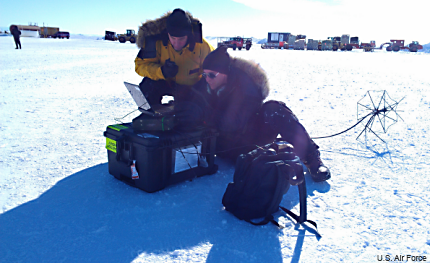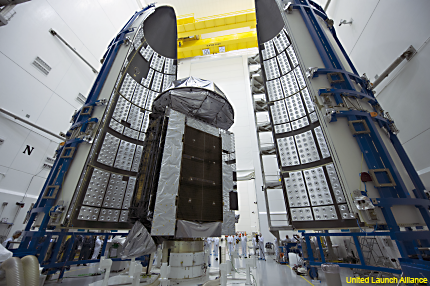Researchers take high-bandwidth communications to the South Pole
With MUOS, developed by AFRL, the Navy and Lockheed Martin, researchers send the first voice-and-data communications from Antarctica.

Members of a team from the Air Force, Navy and Lockheed Martin test MUOS in Antarctica.
In the next step toward supplying cell phone-like, but satellite-based, communications around the globe, the military has now successfully tested the Mobile User Objective System (MUOS) in the Antarctic, sending the first ever voice-and-data communications involving the continent.
MUOS is a direct-sequence spread spectrum Wideband Code Division Multiple Access (WCDMA) waveform that operates via dedicated satellites and transmits signals at 16 times the rate of the current Ultra High Frequency satellite system—on both unclassified and classified networks—giving users both greater capacity and range.
"Think about how you feel when you don't have cell phone coverage, especially when you need it most," Michael Gudaitis, the Air Force Research Laboratory’s team lead for the tests, said in an AFRL release. "In Antarctica, with the MUOS system we were able to demonstrate calls from places where no other radio or cellphone would work."
AFRL’s team hitched a ride to Antarctica with the 62nd Airlift Wing on the annual resupply mission—called Operation Deep Freeze—for the National Science Foundation, McMurdo and Amundsen-Scott stations, AFRL said. The team then sent out the continent’s first voice-and-data communications within 20 minutes of arriving.
Researchers compared MUOS to a 3G cell-phone system, except that it uses satellites in geosynchronous orbit (22,000 miles above the Earth) instead of cell towers. It also doesn’t use typical commercial cell phones, instead employing tactical radios such as the AN/USC-61(C) Digital Modular Radio, which the Navy has been ordering.
MUOS, developed by AFRL, the Navy and Lockheed Martin, is a four-satellite constellation designed to deliver high-bandwidth communications around the globe. With the first two satellites, launched in 2012 and 2013, in orbit, the Navy demonstrated its reach in the Arctic during tests in 2013 and early 2014.
MUOS-3 was launched in January this year and by June had completed testing and been moved into its on-orbit slot, giving the system coverage of about three-quarters of the Earth. The fourth satellite is scheduled for launch Aug. 31 and will give the system near-global coverage, Lockheed Martin has said. A fifth MUOS satellite, a spare with additional legacy capability, is expected to be launched in 2016.

MUOS-4 is encapsulated in its launch vehicle earlier this month at Cape Canaveral.
During tests of MUOS, AFRL and the Navy are using the data collected to improve the system, which already could have one advantage of commercial cells phones, Gudaitis said. "On an airline flight you can't use your cell phone except in 'airplane mode,'" he said. "But with MUOS you can stay connected at all times.




